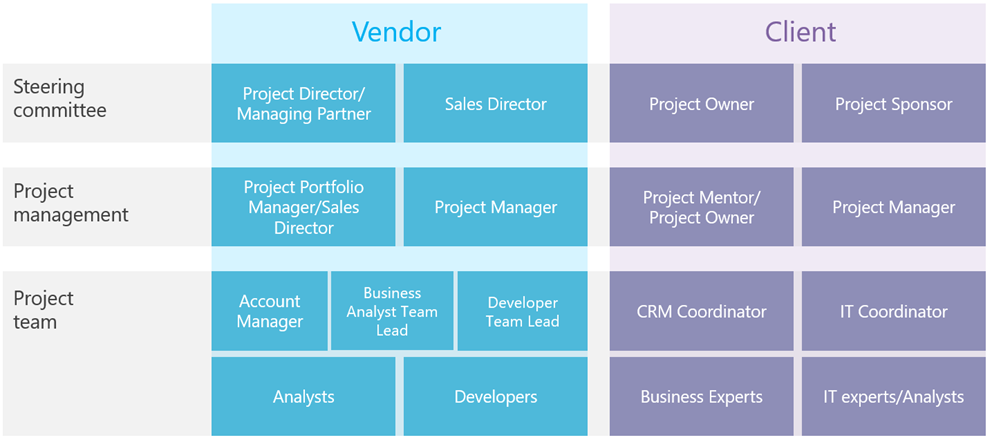External implementation implies that the Client and Vendor are separate companies.
An external implementation project workgroup consists of Client’s and Vendor’s representatives and is divided into three levels (Fig. 2).
•Steering committee
•Project management
•Project team.
Fig. 2 Project workgroup structure for external implementation

Note
An employee of the Client (or Vendor) can have several roles in the project workgroup if needed.
If possible, all project decisions should be taken at the lowest level. If the issue cannot be solved on its level, project members escalate it on higher level up to the Steering committee. The Steering committee should therefore include persons, authorized to make any decisions related to the project.
Contents
See also
Project team includes employees responsible for project execution: preparing, development, testing and implementation.
Vendor
Analysts – direct performers of the project. Analysts develop the Business concept and Technical design of project solutions, define tasks for developers, train Client’s employees and check the quality of the project solutions.
Developers – direct performers of the project. They are responsible for the development of project solutions based on the Business concept and Technical design.
Account Manager – a representative from the Vendor’s commercial department responsible for commercial and organizational issues (being present during business trips, conducting presentations, etc.) as well as the preparation of documents.
Business Analyst Team Lead – direct manager of analysts. Responsible for the quality and performance control.
Developer Team Lead – direct manager of developers. Responsible for the quality and performance control.
Client
Business Experts – Client’s employees who are highly loyal and know the company business specifics and key performance indicators. Business experts are key users who will be using the implemented system in their everyday work. They test the developed functions and provide feedback from the business perspective.
IT experts/Analysts – representatives of the Client’s implementation department (if exists).
CRM Coordinator – Client’s representative, responsible for the implementation of developed functions. Trains employees, motivates them to use Creatio, implements guidelines. This employee also coordinates the work within the Client's project team and is often a Creatio administrator.
IT Coordinator – manager of the Client’s IT department. Responsible for the deployment of testing and production environments, integration of project features and other technical issues.
This group includes project managers from Client’s and Vendor’s side, who have the authority to solve general project development and progress issues.
Vendor
Project Portfolio Manager – the Vendor’s representative who is responsible for specific portfolio of projects, direct superior of the Project Manager.
Project Manager – Vendor’s representative who is responsible for the project completion and general project management. Their responsibilities include project planning, prioritizing and task management, timings and performance control, communication and closing issues.
Client
Project Mentor – project owner or a top-manager of the Client company, stands above the Project Manager, makes decisions on the project infrastructure and development.
Note
If the Project Mentor role is not present in the Client’s team, then the project owner can take over this role.
Project Manager – Client’s representative who accepts the completed project and supervises the work on the Client’s side.
The Steering committee includes the client’s top-management. This is the main decision-making authority in the project. The issues that failed to be resolved at lower levels must be escalated to the Steering committee level.
Vendor
Managing Partner – a top-manager of the Vendor’s company. The Managing Partner is the final authority in resolution of any project-related issues.
Project Director – a manager in the Vendor’s company, responsible for the vendor’s entire project business line and project portfolio.
Sales Director (commercial director) – a manager in the Vendor’s company, responsible for sales of services and products.
Client
Project Owner – a top-manager of the Client’s company, directly interested in the project results, or a manager of the department that will be using the implemented product.
Project Sponsor – a top-manager of the Client’s company, responsible for the financing and budget of the project. Makes decisions on expanding the budget.
Project Owner and Project Sponsor both have the authority to make any decisions on the project. Usually, the Project owner and Project Sponsor are the owners of the Client's business.
See also






